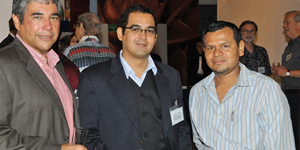by Luz Helena Oviedo
PCP-PIRE has developed several communication and education efforts to step out of the ivory tower and engage the different audiences involved in the project. The main objectives of this portion of the project were presented by Bruce MacFadden during the Education and Outreach section of the PCP-PIRE meeting. George Angher from the BioMuseo, one of PCP-PIRE partners, gave attendees an overview of the different galleries of this future museum that will feature the rise of the Panama isthmus and its outstanding biodiversity.

Three PCP-PIRE communication products were presented: a short documentary, the monthly newsletter and the website. These were presented by Andy Kilmer, Luz Helena Oviedo and Claudia Grant, respectively. The Facebook page of the project was mentioned in the talks and the number of followers almost doubled after the meeting. All the talks were announced on Facebook and participants that could not attend were able to follow the meeting activities through this social media.
Jorge Pino and Catalina Pimiento described the work that is being done with Panamanians at the Museo de Ciencias Naturales and volunteers from the University of Panama. These initiatives are part of the project’s efforts to build local capacity.
PCP-PIRE seminar is available at www.stri.si.edu/english/webcast/recent_webcasts.php.
por Luz Helena Oviedo
El PCP-PIRE ha realizado varios esfuerzos de comunicación y educación para salir de la torre de marfil y enganchar a las diferentes audiencias involucradas en el proyecto. Los objetivos principales de esta parte del proyecto, fueron presentados por Bruce MacFadden durante la sesión de Educación y Divulgación de la reunión del PCP-PIRE. George Angher del BioMuseo, uno de los colaboradores del PCP-PIRE, ofreció a los asistentes una visión de las diferentes galerías de este futuro museo que presentará el surgimiento del istmo de Panamá y su impresionante biodiversidad.

Se presentaron tres de los productos comunicacionales del PCP-PIRE: un corto documental, el boletín mensual y el sitio web. Estos fueron presentados por Andy Andy Kilmer, Luz Helena Oviedo y Claudia Grant, respectivamente. Uno de los productos mencionado en las charlas, fue la página de Facebook del proyecto, en la cual el número de seguidores casi se dobló, después de la reunión. En esta página también se realizó el seguimiento de las charlas permitiendo que los participantes que no pudieron asistir estuvieran al tanto de la actividad.
Jorge Pino y Catalina Pimiento describieron el trabajo que se ha hecho con panameños en el Museo de Ciencias Naturales y con voluntarios de la Universidad de Panamá. Estas iniciativas hacen parte de los esfuerzos del proyecto para construir capacidad local.
El seminario del PCP-PIRE está disponible en www.stri.si.edu/english/webcast/recent_webcasts.php.